Muzio Clementi – Composer, Pianist & Instrument Maker
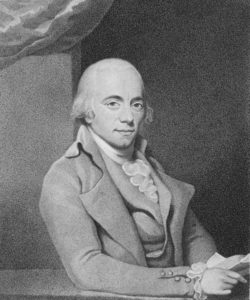
Muzio Clementi (originally Mutius Philip Vincentius Franciscus Xaverius Clementi) was born on January 23, 1752 in Rome. His parents were Niccolo Clementi (1720 – 1789) and his second wife Magdalena Caisar. The father worked as a goldsmith. Muzio had a total of 7 brothers and sisters of which only three survived: Gaetano (1757 – 1806), Maria Luigia (b. 1759) and Regina (b. 1764). At the age of six he received his first music lessons from Antonio Boroni (1738 – 1792). This was followed by Giovanni Battista Cordicelli, Giuseppe Santarelli (1720 – 1790) and Gaetano Carpani (1692 – 1785) as his teachers.
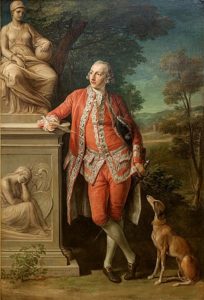
Sir Peter Beckford (1740 – 1811) – Painting by Pompeo Batoni, 1766
At the age of 14 the Englishman Sir Peter Beckford (1740 – 1811) became aware of the boy during one of his travels and took him to England. In 1774 Clementi went to London and gave a series of successful concerts and became a celebrated pianist, composer and teacher of international renown.
From 1780 – 1785 Clementi undertook several concert tours. He played in Paris, Strasbourg, Bordeaux, Berlin, Bern or Vienna. The highlights of these trips undoubtedly included Clementi’s appearance in Paris playing in 1780 for Marie-Antoinette and also his stay in Vienna, where he played on Christmas Eve 1781 for Emperor Joseph II a musical contest against Wolfgang Amadeus Mozart. Clementi’s great successes made him well known throughout Europe.
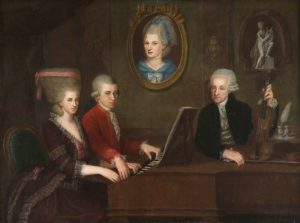
The Mozart Family – Painting by Johann Nepomuk della Croce, c. 1780
After his final return to London in 1785, he was appointed composer and first performer of the Hanover Square Grand Professional Concerts. He was considered as an excellent teacher and teaches many famous students like Johann Baptist Cramer, Benoît-Auguste Bertini or John Field. Towards the end of the 1790s, Clementi began to work increasingly as an entrepreneur in music trade.
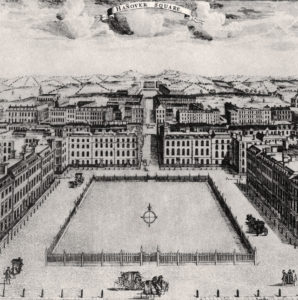
Hanover Square c. 1790
In 1798 he took over the insolvent company “Longman & Broderip”. For a short time the company acted under the name “Longman, Clementi & Co.” (a few pianos from that time have been preserved). After James Longman retired in 1800, he founded the company “Clementi & Co.” (with partly changing partners). The address of the company was then No. 26 Cheapside and from 1802 also in Tottenham Court Road.
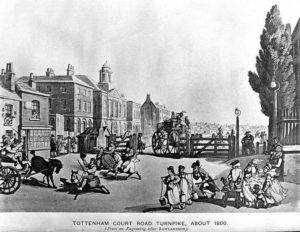
Tottenham Court Road c. 1800 – Engraving after Rowlandson
On March 20, 1807, a devastating fire destroyed the warehouse at Tottenham Court Road. The total damage amounted to over £40.000. With the help from various business partners and money reserves from the company the warehouse was rebuilt quickly. This quick set-up was essential, as Clementi stood in great competition with John Broadwood’s piano company (to which he himself maintained excellent personal contacts). Also in 1807 Clementi concluded an exclusive contract with Ludwig van Beethoven (1770 – 1827), which assured him all rights to the publication of all his works. Clementi edited the works and published them. However, he had to accept some criticism, as he himself made “harmonic corrections” to some of Beethoven’s works.
Clementi was very interested in technical innovations on instruments and actively contributed to improvements in new techniques and sounds. During the period from 1802 to about 1810, his travels increased again. He travelled to Riga, St. Petersburg, Zurich, Prague or Milan to sell his instruments and to establish and expand contacts with various publishers and music sellers. He was very successful and his business flourished very well.
In 1811 he married Emma Gisborne, with whom he had four children: Vincent, Caecilia Susannah, Caroline and John. The only surviving portrait of Emma Gisborne Clementi was painted by Thomas Hardy (1756 – 1804) and belongs also to the Eric Feller Collection. It shows her in front of a Clementi square piano with a music book in her hand.
In 1822 the brothers Frederick William and William Frederick Collard bought into the company (henceforth “Clementi, Collard & Collard“).
However, Clementi sold his entire shares in 1830 to the two brothers and retired at Lyncroft House.

Signature by Muzio Clementi (1752 – 1832) – Eric Feller Collection
On March 10, 1832 he died at his country house in Evesham, Worcestershire. He was buried on March 29, 1832 in Westminster Abbey. The company was then taken over by the two brothers under “Collard & Collard“.
His legacy passed to his widow Emma with numerous unpublished manuscripts, which were then passed on to his grandson. His compositions influenced the classical period in a sustainable way. For a long time Clementis music was forgotten and overshadowed by Mozart, Beethoven or Haydn, although he was celebrated during his lifetime.
An important work, which has been receiving constant attention since published, is Clementi’s “Gradus ad Parnassum“, Op. 44 which appeared in three volumes (published in 1817, 1819 and 1826).
Here you can download the three volumes of the French first edition published by Erard:
- Gradus ad Parnassum – Volume 1 – 1817 (click here)
- Gradus ad Parnassum – Volume 2 – 1819 (click here)
- Gradus ad Parnassum – Volume 3 – 1826 (click here)
Also important but less well known is Clementi’s “Introduction to the Art of Playing on the Piano Forte” Op. 42.
Here you can download the English first edition from Clementi’s own publishing company: Clementi, Banger, Hyde, Collard & Davis, c. 1803.
In addition to these books, Clementi’s compositions further influenced the music taste of his period far beyond and also had a huge influence on other composers. Today his music is getting played more and more.
British musicologist Alan Tyson (1926 – 2000) published a thematic catalogue of works by Clementi in 1967. Here you can download the catalogue for further information:
Sources:
- Anderson, Emily (Hrsg.): The Letters of Mozart and his Family. London: Palgrave Macmillan, 1989.
- Appleton, Elizabeth: Private Education, or A Practical Plan for the Studies of Young Ladies. London: Henry Colburn, 1816.
- Burney, Charles: A General History of Music from the Earliest Ages to the Present Period (1766–1784). London: G. T. Foulis, 1935.
- Gerhard Anselm: London und der Klassizismus in der Musik. Die Idee der „absoluten Musik“ und Muzio Clementis Klavierwerk. Metzler, Stuttgart u. a. 2002.
- Humphries, Charles; Smith, William C.: Music Publishing in the British Isles, from the Beginning until the Middle Part of the Nineteenth Century. New York: Barnes & Noble, 1970.
- Plantinga, Leon: Clementi: his life and music. London – New York – Toronto: Oxford University Press, 1977.
- Plantinga, Leon: Clementi, Virtuosity, and the German Manner. Journal of the American Musicological Society, XXV, 1972.
- Tyson Alan: Thematic Catalogue of the Works of Muzio Clementi. Schneider, Tutzing 1967.
- Unger, Max: Muzio Clementis Leben. Langensalza: Hermann Beyer und Söhne, 1914.
© Eric Feller – Early Keyboard Collection – December 2018

